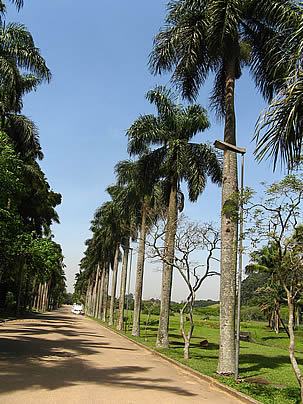The Puerto Rico Royal Palm (Roystonea borinquena) is an imposing species with a bottle-shaped trunk, native to Puerto Rico, the Virgin Islands, and the Dominican Republic in the Caribbean. Its stem (trunk) is unique, smooth, light gray in color, and bottle-shaped, with the base wider and gradually thickening after a certain height. The palm heart area is long and showy, green in color, and the leaves are pinnate, long, feather-like, arched, and drooping.
Of large size, this palm tree reaches a height of 39 to 98 feet (12 to 30 meters) and a diameter of 10 to 27.5 inches (25 to 70 centimeters). Inflorescences appear in individuals over seven years old and annually thereafter. They are panicles composed of small, male and female, cream-yellow flowers with reddish anthers. The male flowers all open and fall before the female flowers open, thus preventing self-pollination. They are rich in nectar and attract many bees. The formed fruits are ellipsoidal, black when ripe, attracting birds. Each fruit contains a single, fat-rich seed, used in the production of animal feed in the countries of origin.
A bottle-shaped palm tree, fast-growing (up to one meter per year), and the typical splendor of the Roystonea genus of royal palms. The Puerto Rico Royal Palm is ideal for creating avenues on large streets or accompanying sumptuous buildings such as malls, monuments, museums, luxury condominiums, clubs, etc. Avoid planting it in small spaces, where it will likely appear disproportionate. Due to its non-aggressive, hair-like roots, it is suitable for planting on sidewalks, near buried pipes, or around swimming pools. The wood can be used in construction, but it is not very durable and is susceptible to termites.
It should be grown in full sun in sandy to clayey soils, neutral to slightly alkaline, enriched with organic matter, and regularly irrigated. This palm tree appreciates humidity and prefers heavier soils where more water is available. It is resistant to maritime salinity, pollution, and strong winds, including tornadoes and hurricanes. Very resistant to transplantation.
Avoid planting the Puerto Rico Royal Palm in locations with limited water availability, as it is quite water-demanding. It can be propagated by seeds, freshly harvested and depulped from ripe fruits, placed to germinate in a substrate kept moist. It germinates in about 3 months. Young seedlings can be grown in full sun from an early age without harming their foliage and growth.


